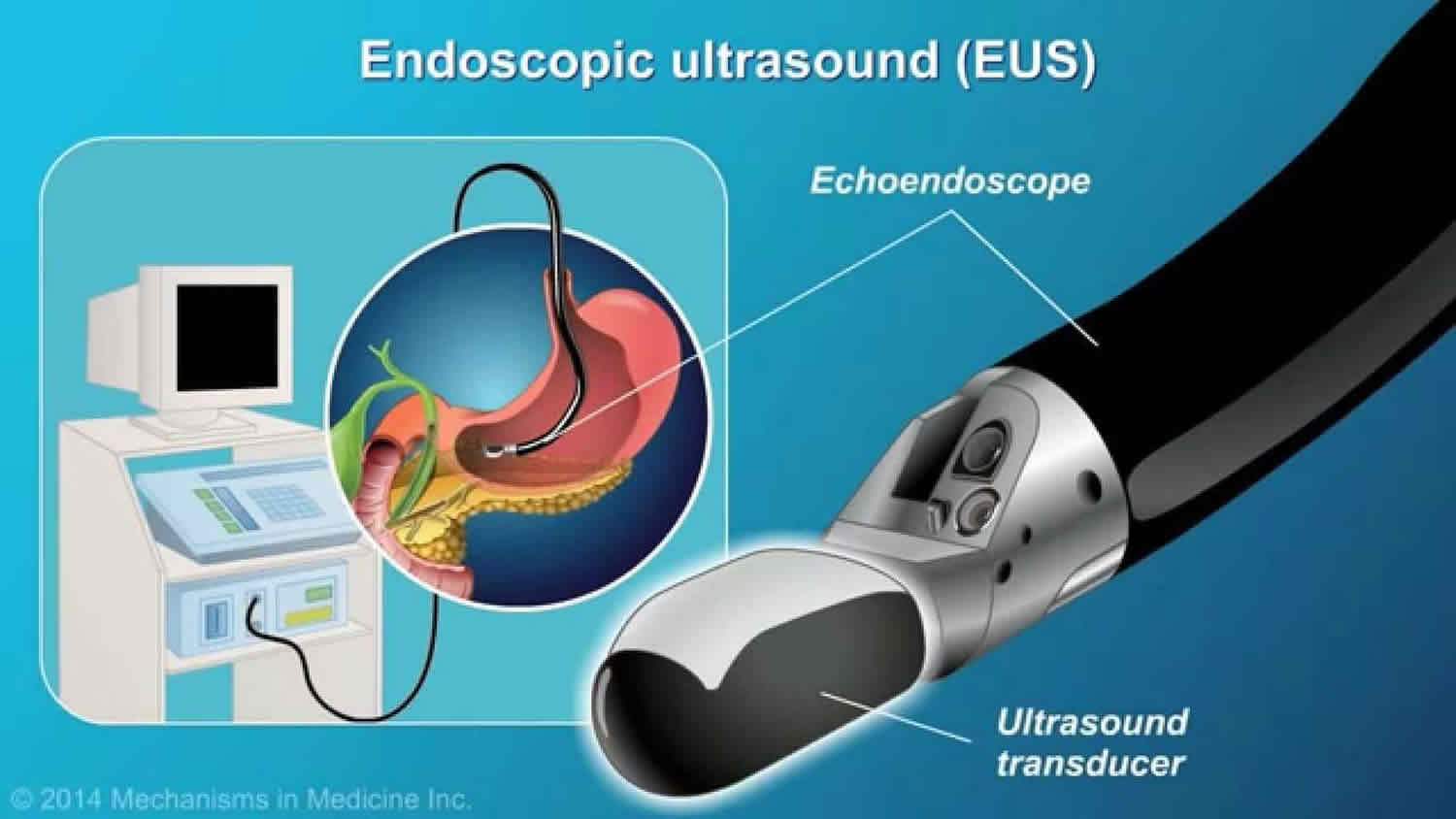Contents
What is EUS
EUS is short for endoscopic ultrasound, which is a minimally invasive procedure that combines endoscopy with the diagnostic abilities of ultrasound. EUS is used in the imaging of the upper digestive (gastrointestinal) tract and surrounding structures as well as the respiratory tract (where it is referred to as endobronchial ultrasound, EBUS). A special endoscope uses high-frequency sound waves, typically in the range of 12-20 Megahertz, to produce detailed images of the lining and walls of your digestive tract and chest, nearby organs such as the pancreas and liver, and lymph nodes. Endoscopic ultrasound (EUS) was developed as a less invasive alternative to surgery and radiology and is now used in appropriate patients after failed endoscopic retrograde cholangiopancreatography (ERCP).
When combined with a procedure called fine-needle aspiration (FNA), EUS allows your doctor to sample (biopsy) fluid and tissue from your abdomen or chest for analysis. EUS with fine-needle aspiration can be a minimally invasive alternative to exploratory surgery.
EUS procedure is also used in certain treatments, such as draining pseudocysts.
EUS is performed on an outpatient basis and is well-tolerated by most people.
You may not be a candidate for EUS if you have had abdominal surgery that changed your anatomy, such as Roux-en-Y gastric bypass.
Why is EUS done?
EUS is used to find the cause of symptoms such as abdominal or chest pain, to determine the extent of diseases in your digestive tract and lungs, and to evaluate findings from imaging tests such as a CT scan or MRI.
EUS may help in the evaluation of:
- Cancer of the colon, esophagus, lung, pancreas or stomach, and ampullary and rectal cancers
- Lymphoma
- Barrett’s esophagus
- Neuroendocrine tumors
- Pancreatitis and pancreatic cysts
- Bile duct stones
- Sarcoidosis
EUS can help:
- Assess how deeply a tumor penetrates your abdominal wall in esophageal, gastric, rectal, pancreatic and lung cancers
- Determine the extent (stage) of cancer, if present
- Determine if cancer has spread (metastasized) to your lymph nodes or other organs
- Provide precise information about non-small cell lung cancer cells, to guide treatment
- Evaluate abnormal findings from imaging tests, such as cysts of the pancreas
- Guide drainage of pseudocysts and other abnormal collections of fluid in the abdomen
- Permit precise targeting for delivering medication directly into the pancreas, liver and other organs
EUS procedure risks
EUS is generally safe when performed at a center with an experienced and expert health care team. Your doctor will discuss with you the risk of complications from EUS. These risks are most commonly associated with fine-needle aspiration.
EUS Risks may include:
- Bleeding
- Infection
- Tearing (perforation) of the intestinal wall or throat
- Pancreatitis, if fine-needle aspiration of the pancreas is done
You can reduce your risk of complications by carefully following your doctor’s instructions for preparing for EUS.
See your doctor immediately or go to an emergency room if you experience any of the following signs or symptoms:
- Fever
- Chest pain
- Shortness of breath
- Black or very dark-colored stool
- Severe or persistent abdominal pain
EUS procedure prep
Your doctor will give you specific instructions to prepare for your EUS. You may be asked to:
- Fast before EUS, to make sure your stomach is empty. Generally, you’ll be asked to fast for at least 6 hours before the test.
- Prepare your rectum, if EUS is being done in the rectal area. You may be asked to take a laxative or have an enema and to follow a liquid diet before the procedure.
- Stop taking certain medications, such as blood thinners. Blood thinners may increase your risk of bleeding if fine-needle aspiration is performed during EUS. If you have chronic conditions, such as diabetes or high blood pressure, your doctor will give you specific instructions regarding your medications.
- Plan ahead for your recovery, if you will be sedated before EUS. Most people who have EUS are given medication to relax them. Arrange for someone to drive you home after the procedure.
EUS procedure
You likely will be given medicine to help you relax.
During EUS your doctor passes a thin, flexible tube (endoscope) through your mouth and through your digestive tract. A small ultrasound device (transducer) in the tube produces sound waves that create a precise image of surrounding tissue, including lymph nodes in the chest. The endoscope is then gradually withdrawn.
If you have fine-needle aspiration with EUS, your doctor may need to pass a second, curved device through a channel in the endoscope into your digestive tract. That device can guide a very slender needle to your lymph nodes and tumors or other abnormalities. The needle extracts fluid and tissue for analysis.
EUS with fine-needle aspiration generally lasts less than an hour.
EUS procedure results
A specialist in digestive diseases (gastroenterologist) or lung disease (pulmonologist) with special training in EUS will interpret the EUS images. A doctor trained in analyzing biopsies (pathologist) will report the test results if you have fine-needle aspiration. Your doctor will discuss any important findings and next steps with you.





